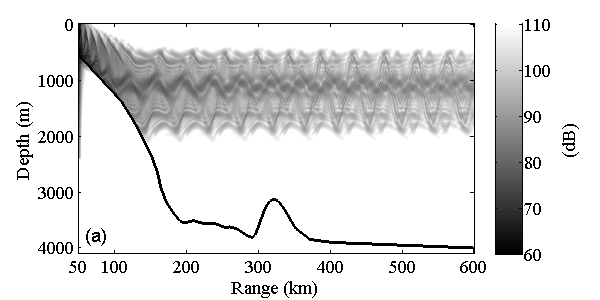Sound propagation in range-dependent ocean environments has long been recognized as a difficult modeling and prediction problem, which has also received considerable attention in the ocean acoustics community.
An experiment was conducted in the Northwestern Pacific, from which a phenomenon was observed. The phenomenon showed that the energy of the received signal near the sound channel axis was much stronger than that at shallower depths. The received signal was launched from a non-cooperative air-gun source far from deep water.
To interpret this phenomenon, sound propagation from the shelfbreak to deep water is studied by QIN Jixing, ZHANG Renhe (CAS Member), LUO Wenyu, et al. from the Institute of Acoustics, Chinese Academy of Sciences.
For investigating sound propagation over a downslope, numerical simulations are proposed (see Fig. 1), from which the following conclusions are reached. When the source is located near the sea surface, sound will be strongly attenuated by bottom losses in a range-independent oceanic environment, whereas it can propagate to a very long range because of the continental slope. When the source is mounted on the bottom in shallow water, acoustic energy will be trapped near the sound channel axis, and it converges more evidently than the case where the source is located near the sea surface.

Fig. 1 Transmission loss versus range and depth. The source depth is 550 m (Image by QIN).
Numerical simulations are performed with different source ranges with the source placed near the sea surface to interpret the experimental phenomenon qualitatively. By comparing the relative energy level in the vertical direction between the numerical results and the experimental data, the range of the air-gun source can be approximated (see Fig. 2).

Fig. 2 Relative energy level versus depth at the range of the vertical line receiver array with 10-km source range. The source depth is 10 m. The solid line corresponds to the simulation result, and the circle markers correspond to the experimental result (Image by QIN).
Journal References:
QIN Jixing, ZHANG Renhe, LUO Wenyu, PENG Zhaohui, LIU Jianjun and WANG Dejun. Sound Propagation from the Shelfbreak to Deep Water. SCIENCE CHINA Physics, Mechanics & Astronomy (vol. 57, no. 6, pp. 1031–1037, June 2014). DOI: 10.1007/s11433-013-5297-9
Corresponding Author:
QIN Jixing
State Key Laboratory of Acoustics, Institute of Acoustics, Chinese Academy of Sciences, Beijing 100190, China
E-mail: qjx@mail.ioa.ac.cn


